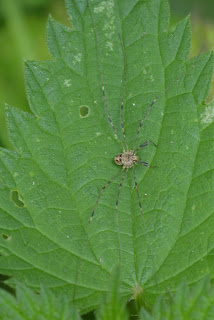 |
| Photograph: Jim Cresswell |
We met in the site's car park. Unfortunately the first impression was of litter. Not the best start. As we passed through the entrance gate and the information board we then noticed a couple of reminders that this is a dog-walking area.
(Dog-walkers - please clean up after your dog does what a dog has to do.)
At the bottom of the entrance path we crossed the main path along the site and made our way through a thin strip of trees to the bank of the River Tern. The bank was nettle infested but these together with the bordering trees provided an abundance of things for us to look at.
Yes, there is a river in the above photograph! Here it is at a slightly different angle
If you look very carefully at the first photograph in the lower middle you will see some hints of an orange flower. Here is the same plant species further downstream
It is Orange balsam
In an alder bordering the spot where we stood we found the Alder tongue fungus.
 |
| Photograph: Jim Cresswell |
 |
| Photograph: David Williams |
We moved on. The site opened out into a meadow that had not been "managed" for a long time and was now home to nettle, dock, hogweed and thistles amongst other things. There were a few patches where grass could be found together with some stands of ragwort that provided late season nectar for hoverflies, bees and other insects.
Despite the "poor" quality of the grassland it provided a home for plenty of insects including many species of shieldbugs and their allies. Here is one - a dock bug, on dock.
A harvestman was found clinging to a nettle leaf.
 |
| Dicranopalpus ramosus - Photograph: Jim Cresswell |
 |
| Photograph: David Williams |
 |
| Photograph: Les Hughes |
Now, as you will know, morning coffee time for most is lunchtime for some, especially me. But I resisted for half an hour or so as there was plenty to look at in the grassland, then made for the bench that some morning coffee-ers were still occupying.
Amazingly it became lunch-time for everyone.
Lunch over, passing the next small area of woodland, we moved into a second meadow that looked very much like the first. Like the first it supported an abundance of life. They may not have been rare or unusual species, but they were there!
I glanced at some woundwort and to my amazement saw a couple of Woundwort shieldbug nymphs.
 |
| Photograph: David Williams |
 |
| Leptura quadrifasciata - Photograph: David Williams |
And very close by were two dock bugs enjoying the afternoon sun. (No photograph - you have already had one today.)
Nearby the River Tern flowed on.
So, despite the apparent "poor" quality of the grassland, it was bursting with life.
We wandered past another clump of trees into the third meadow. This was very much like the others but with a slightly different, more dense, plant population that hemmed in the path. However, the river did occasionally come into view.
A common plant along this part of the river bank was Marsh woundwort.
We came to a fallen tree that blocked the path. This seemed to be a sign that it was time to turn around. We did. We backtracked and assembled around a riverside bench for afternoon tea. (We are a very civilised group.)
One of the group was carrying a stick. It turned out to be two sticks stuck together by Glue fungus
The gist of the process, as I understand it, is that the fungus present in the first stick somehow detects when another stick is resting against it. The fungus then invades the second stick for additional nutrition and creates a crust that glues the two objects together. In this state the fungus is now a happy fungus. Happy enough to produce a fruiting body as seen in the following photograph.
On that happy note we returned to our transport and made our way home passing as we did a couple more shieldbug species
Hairy shieldbug
 |
| Photograph: David Williams |
 |
| Photograph: David Williams |
My thanks to Shropshire County Council for granting us permission to survey and to Jim Cresswell, David Williams and Les Hughes for the additional photographs.









































































